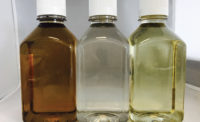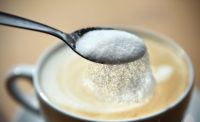Cleaning up sweeteners

Chicory-root fiber blend with high-intensity sweeteners to mask their aftertaste and provide a more natural, sugar-like sweetness, says Joseph O’Neill of Beneo. Photo courtesy of Beneo

A big challenge for the food industry is reducing calories while maintaining the taste experience, says Abigail Storms of Tate & Lyle. Photo courtesy of Tate & Lyle


What do black licorice, The Grateful Dead and Vani Hari (a.k.a. the Food Babe) have in common? Answer: People either love ‘em or loathe ‘em. For those in the food industry, it’s a good bet that the verdict on the Food Babe leans toward the latter.
That’s because when she talks, consumers listen. And perhaps it’s because she writes things like this on her blog: “Don’t buy, consume or keep products in your house with the following ingredients in them: barley malt, beet sugar, brown sugar, buttered syrup, caramel, carob syrup, corn syrup, corn-syrup solids, dextran. dextrose, diastase, diastatic malt, ethyl maltol, fructose, glucose, glucose solids, high-fructose corn syrup, invert sugar, lactose, malt syrup, maltodextrin, maltose, mannitol, malitol, raw sugar, refiner’s syrup, sorbitol, sorghum syrup, sucrose, turbinado sugar, yellow sugar.”
The pretty much wipes out the sweetener shelf, doesn’t it?
Setting aside the validity of her advice — to say nothing of any science substantiating it — Hari wields a powerful megaphone. Her messages get traction. As Catherine Barry of the National Honey Board, Firestone, Colo., said, “Simply put, food is no longer just food. It’s science, medicine, entertainment and more. It’s something that’s analyzed and dissected constantly.”
Barry, the director of marketing for the honey board, said sweeteners “have come under more scrutiny than most other ingredients.”
Dairy formulators aren’t taking this lying down. Then again, they are not in the business of snubbing consumers. That is why “dairy food and beverage manufacturers are meeting the demands of consumers by producing more clean-label products,” Barry said.
Clean and clear
Scott Turowski has no illusions about the power of opinion makers in driving the clean-label debate.
“There are several figures in the media who have established credibility with consumers and have a strong influence on their opinions and decisions,” said the technical sales manager for Sensus America Inc., Lawrenceville, N.J. “There are many examples of these personalities making claims and issuing warnings without thoroughly reviewing the science. The misinformation drives perceptions and creates distrust of the food industry as a whole. I think it has really had a lot to do with the trend toward clean-label formulations.”
Said Thom King, CEO and president of Steviva Ingredients, Portland, Ore., “A lot of data support consumer demand for clean-label and natural sweeteners. Going natural gives manufacturers a competitive advantage.”
The trends-watching firm Innova Market Insights chose “clear labeling” as one of its leading formulation trends to watch in 2015. It reflects “a move to clearer and simpler claims and packaging for maximum transparency,” said Lu Ann Williams, director of innovation at the Duiven, Netherlands-based research firm. Clean label claims appeared on nearly a quarter of all food and beverage launches, according to a press release from Innova. But absent much clarity on what “clear” or “clean” actually means, consumers and product developers are left to define the concept for themselves.
The meaning of clean
For consumers, their best way to define what clean is might be: “I know it when I see it.”
“In this case, perception is reality,” said Joseph O’Neill, president and general manager of Beneo Inc., Morris Plains, N.J.,
“What we’re seeing is that although consumers are demanding and moving toward clean label, some of their favorite traditional products or preferences are still a part of the mix. So it’s about balance,” said Ivan Gonzales, the dairy marketing director at Ingredion Inc., Westchester, Ill.
He added that different generations place different weight on the concept, with Millennials “spending more despite having less, and making more conscious decisions to eat healthy.”
For King, a “clean-label” sweetener is one that’s naturally derived via “either fermentation or natural water and vegetable-alcohol extractions,” he explained. That excludes “chemically derived or treated sweeteners” like aspartame, acesulfame potassium and sucrose.
For his part, Turowski sees the category as “generally including products that consumers can recognize and relate back to their agricultural sources.”
And yet when shoppers encounter these same sweeteners labeled with their chemical names (oligofructose for chicory-root fiber, for example), perceptions change.
“In these cases,” Turowski said, “it often doesn’t matter if a sweetener is considered natural if the name sounds too ‘chemical.’”
A fiber by any other name
And that’s a pity for those of us who like saying “oligofructose.” But it hasn’t hurt demand for the very same sweetener marketed with the more “natural”-sounding name. Even inulin, which is yet another way of describing chicory-root fiber, is a term that consumers seem to have warmed to.
In any case, the sweetener “has been able to take advantage of the natural-sweetening trend and has received increased consumer acceptance when referred to as chicory-fiber extract or chicory fiber on the ingredient legend,” O’Neill said.
At heart, chicory-root oligofructose is a polymer of fructose belonging to the fructan class of compounds, and while a highly soluble prebiotic fiber, it has a mildly sweet taste and functional properties similar to high-fructose corn syrup, Turowski said. It is used in dairy formulations across the board — from fruit preps and flavored milks to ice cream, yogurt and flavored cheeses. It not only improves label appeal but also boosts fiber content and delivers sweetness.
The level of that sweetness doesn’t quite match traditional sugar’s, as chicory-root fiber can range from about 30% sucrose’s sweetness to upwards of 60%, depending on the ingredient. But at 1.5 kcal/g compared to sugar’s 4 kcal/g, it offers caloric advantages and “can blend with high-intensity sweeteners to mask their aftertaste and provide a more natural, sugar-like sweetness,” O’Neill said.
Even better, inulin can stabilize water into a cream structure with the same mouthfeel as fat, he said. So not only does it clean up a formulation’s sweetener quotient; it can help replace some of its lipids, too.
The bee’s knees
No wonder chicory-root fiber (or oligofructose, if you like) is as popular with formulators as with consumers. All the same, some shoppers still prefer not just subjectively clean sweeteners, but those that are also familiar to them, Barry said. “They want ingredients they can find in their pantries.”
Naturally, she’s talking about honey. Honey comes by its clean-label credibility naturally. After all, “Bees make honey from the nectar of flowers,” Barry said. “This is not a sweetener that’s formulated or manufactured in a facility.”
In the yogurt aisle, shoppers can find a variety with honey. “Some even offer honey in a ‘sidecar’ that consumers can mix in manually,” Barry said.
Spreadable cream cheeses and nut butters also include honey “to capitalize” on consumer cravings for more flavored products, she said. Even flavored-milk manufacturers are turning to honey for a sweet, but clean, profile.
Barry said “there’s no significant obstacle to using honey in dairy foods and beverages.”
A hypothetical substitution with honey might require a rebalancing of the water component to account for honey’s roughly 17% moisture content. But other than that, the sweetener still delivers “exceptional” mouthfeel, Barry said, in addition to a clean-tasting sweetness.
Clean and lean
Because honey is 125% to 150% as sweet as sugar, it allows for a slight reduction in total sweetener use. And going forward, achieving that end will be the name of the game. That’s because sweetener reduction is on the public-health agenda.
Consider that the Dietary Guidelines Advisory Committee, which helps draft the blueprints for USDA’s Dietary Guidelines for Americans, recommended in February that we limit our intake of added sugars to 10% of daily calories in an effort to stem obesity and associated diseases. What’s more, FDA is proposing that the Nutrition Facts panel on packaged foods and beverages include a line breaking out the amount of added sugar — regardless of whether it’s HFCS, concentrated fruit juice, agave syrup or beet sugar.
These moves don’t surprise Turowski, who observed that “the prevalence of obesity and the increasing incidence of Type-2 diabetes and other related health problems have clearly been key drivers in leading nutritionists, politicians and consumers to take a closer look at sweeteners in general.”
For generations, industry’s go-to sugar substitutes were conspicuously unclean. But with the development of “natural” high-intensity sugar substitutes, the environment for clean-label sugar reduction has grown more hospitable.
Stevia, at up to 300 times sugar’s sweetness, has led the revolution. London-based Future Market Insights anticipates the global market for the noncaloric sweetener to reach a value of $562.2 million by 2020, largely thanks to consumer preference for natural sugar alternatives.
Yet using stevia presents challenges. Variations in purification and subsequent levels of steviol glycosides — the compounds responsible for the sweetener’s taste — can yield a finished product with bitterness behind the sweetness. That’s why King recommends blending stevia with other clean-label companions to create a sweetener mix that best fits the application at hand.
Blending monk fruit and stevia extracts “cancel out each other’s off notes,” King said. A stevia-erythritol blend and a crystalline fructose-stevia sweetener have helped manufacturers get below the 90-calorie mark in Greek-style yogurts.
A new option that might start showing up in those blends goes by the trade name Dolcia Prima from Tate & Lyle, Hoffman Estates, Ill. The actual sweetener is allulose, a naturally occurring sugar found in fruits, wheat and maple syrup. But what Tate & Lyle brings to the table here is its conversion of the carbohydrates in corn to allulose via its own proprietary process.
Whether that checks out as “clean” or “natural” with the consumers concerned about such things will depend on where they set their conceptual boundaries. But at 0.39 kcal/gram, the new sweetener — which the body doesn’t metabolize — is undeniably lower in calories than sugar, yet “delivers a similar temporal profile as sugar, with a clean, sweet taste,” according to a company fact sheet. Tate & Lyle claims that the ingredient “provides a synergistic relationship with other sweeteners,” and functions like other sugars, depressing the freezing point, contributing to bulk and texture, dissolving readily in aqueous solution and resisting crystallization in high-solids matrices.
As such, it works well in several applications relevant to dairy and sugar reduction, including beverages, yogurt and ice cream.
“One of the biggest challenges our industry faces is reducing calories while maintaining the taste experience consumers expect,” said Abigail Storms, Tate & Lyle’s vice president, platform management, sweeteners, in a statement.
And isn’t that where the focus should be anyway? One consumer’s “clean” may be another’s “chemical,” but calories are calories, and Americans are simply getting too many of them. As more of us catch on to that truth, “the amount of sugar in a particular product will be far more important than the source,” said Turowski.
Looking for a reprint of this article?
From high-res PDFs to custom plaques, order your copy today!







